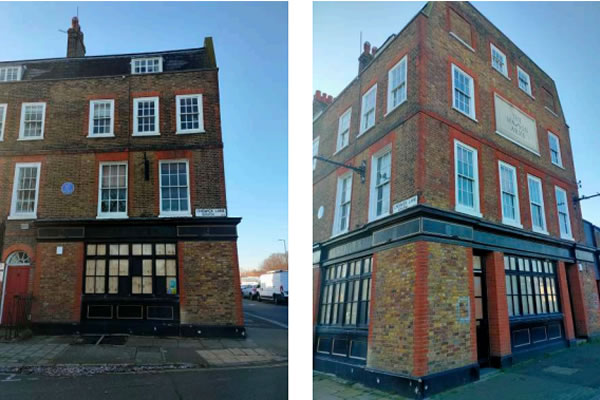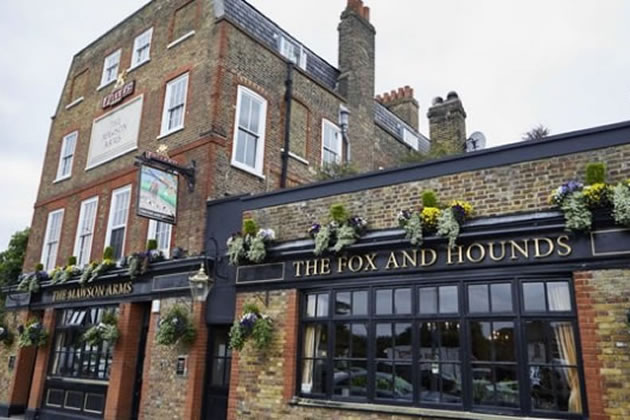Historic Chiswick Pub Could Be Converted into Flats
Mawson Arms/Fox and Hounds site has hosted a pub since 1759

The old Post Office on Church Street from planning documentation
January 19, 2025
A proposal has been made to convert a building in Chiswick which has hosted a pub since 1759 into flats.
The ‘pub with two names’ near Hogarth Roundabout on the corner of Chiswick Lane South, The Mawson Arms and the Fox and Hounds has been vacant since it closed during the pandemic.
Fuller’s said at the time that it had no plans to reopen the pub although the site was not included in the sale of the adjacent brewery to Asahi. It was disposed of later as part of the sale of the Grade II* listed Mawsons Row, the line of early Georgian buildings of which the pub was part.
Fuller’s had been using the upper floors of the Mawson Row buildings (112-118) as offices but vacated them when it moved its headquarters to the Pier House on Strand on the Green.
Permission has already been given for the other buildings on Mawsons Row to be converted to residential use (P/2023/1567) and now property development and investment company Mountley want to do the same for the pub site (number 110 Mawsons Row) which is the northern most building in the row.
The upper floors of the pub are already in residential use so the application (P/2025/0093) covers the ground floor where it is proposed to build a pair of two-bedroom flats with no change in the footprint of the property.
Mawsons Row was built in 1715 and included five terraced houses. The houses and the pub were named after the Mawson family who owned the brewery from 1699-1748. Before it became a pub the building had been in residential use and had been the home of poet Alexander Pope from 1716-19 during which time he translated and published the Iliad and published his first collected works. A blue plaque bearing his name is on the side of the building.
The property was listed at Grade II* in July 1951 and is located within Old Chiswick Conservation Area (OCCA), which was designated in May 1969 and later extended after a review in 2019.
It is thought that the garden house of 110 Mawsons Row was converted into a pub which was originally known as the Fox and Dogs but then became the Fox and Hounds. Around 1898, the two pubs seem to have effectively operated as one. The two names were retained possibly because the publican split the building into an ale house and a separate wine and spirits bar. As a brewery pub, The Mawsons Arms had unusual opening hours often closing at 8pm and rarely being open at the weekend.

The Mawsons Arms and The Fox and Hounds before closure
Its role as the brewery tap ended with the Asahi takeover of the Griffin Brewery and after Fuller’s disposed of it, there were attempts to find new tenants for the site. A marketing report submitted with the application says that, given the location of the pub, it proved impossible to find anybody willing to take it on.
The applicant says that conversion to residential will not harm this heritage asset but will be beneficial and it line with development plan policies with key original features of the building retained.
If you wish to comment on this application, visit the planning section of the Hounslow Council web site and search using the reference P/2025/0093.
Like Reading Articles Like This? Help Us Produce More This site remains committed to providing local community news and public interest journalism. Articles such as the one above are integral to what we do. We aim to feature as much as possible on local societies, charities based in the area, fundraising efforts by residents, community-based initiatives and even helping people find missing pets. We’ve always done that and won’t be changing, in fact we’d like to do more. However, the readership that these stories generates is often below that needed to cover the cost of producing them. Our financial resources are limited and the local media environment is intensely competitive so there is a constraint on what we can do. We are therefore asking our readers to consider offering financial support to these efforts. Any money given will help support community and public interest news and the expansion of our coverage in this area. A suggested monthly payment is £8 but we would be grateful for any amount for instance if you think this site offers the equivalent value of a subscription to a daily printed newspaper you may wish to consider £20 per month. If neither of these amounts is suitable for you then contact info@neighbournet.com and we can set up an alternative. All payments are made through a secure web site. One-off donations are also appreciated. Choose The Amount You Wish To Contribute. If you do support us in this way we’d be interested to hear what kind of articles you would like to see more of on the site – send your suggestions to the editor. For businesses we offer the chance to be a corporate sponsor of community content on the site. For £30 plus VAT per month you will be the designated sponsor of at least one article a month with your logo appearing if supplied. If there is a specific community group or initiative you’d like to support we can make sure your sponsorship is featured on related content for a one off payment of £50 plus VAT. All payments are made through a secure web site. |